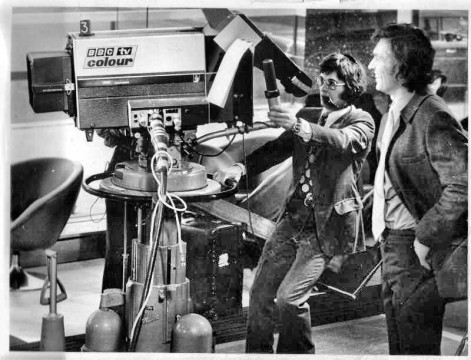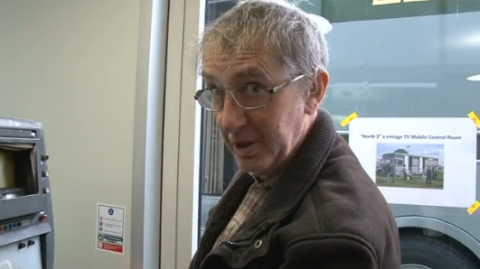Copyright resides with the original holder, no reproduction without permission. (Keith Brook on camera, with Pebble Mill at One presenter, Bob Langley)
EMI 2001 Part 2
In Part 1 I gave a little background to how the Emmy became the size it was by having the Angénieux lens inside the camera.
Here, I’ll show how the compact design had implications that went much further than just the technology and positively affected the quality of programmes, especially drama.
With the early colour cameras, one of the major problems of having a large lens hanging out the front was that as you panned there was a pronounced side-to-side tracking effect from the front element swinging through a large arc. This was most unnatural on drama and some cameramen compensated by tracking the ped in the opposite direction. Not an easy feat with such a cumbersome camera.
On the Emmy, the front of the lens was much closer to the pivot point, as was the cameraman at the other end, and with the steering ring back to its original size, the whole beast became far more compact and manoeuvrable. There are probably loads of other benefits that my colleagues will remind me of, but for me, with the cameraman closer to the drama, the most important of all was that the cameramen became actors in the scenes.
You may find this a strange concept but it was Tim Hardy, ‘Siegfried’ in ‘All Creatures Great and Small’ (yes, that’s his real name), who told me this. He also said the crew gave the cast reassurance, often simply by the body language we were giving off as scenes progressed. Other actors had said the same. I vision-mixed ‘All Creatures’ and I was also surprised when he told me that occasionally the cue lights helped him pace a scene.
The fabulous US anti-terrorist series ’24’ stars Kiefer Sutherland. He has often said that Guy Skinner, their excellent cameraman, was the third actor in the scene.
And it was with us as we danced around the sets, with our ‘short’ Emmys on Vinten peds, matching the actors moves.
Malcolm Carr, ex-BBC Manchester, did an wonderful piece here about the Emmy and mentioned the ‘shot box’. It’s impossible to underestimate just how important that magical device was, especially on drama.
Earlier I said that we often had only a few words, sometimes less than a second, to change the shot size. Zooming manually, you couldn’t guarantee matching the other camera, so EMI kindly added the ‘shot box’ to Monsieur Angénieux’s lens which allowed us to pre-set the lens angles and reproduce them every time. It had 6 memories; 1 and 6 were set to the tight and wide ends and the middle 4, using a chart, were set to match the angles of the old turret lenses 9, 18, 24 and 36 degrees. This wasn’t some attempt at keeping the ‘old tradition’ but rather a nod to the artistic reason why the fixed lenses were the size they were.
A quick word on ‘lens angles’. If you imagine lines coming from the lens and going out to the objects that you see on the left and right of the frame, that’ll give you the lens angle. It’s more intuitive than talking focal length because you can visualise it as you look over the top of the camera.
Ah, I digressed again.
These four lens angles gave us a number of ‘natural’ frame sizes, when related to actors, and they are, CU (close up, 9deg), MCU (medium close up, 18), MS (mid-shot, 24) and MLS (medium long shot, 36). The reason they’re natural is that they enable the actors eyes or centre of interest, as the shot gets wider, to stay on the golden third. The ‘thirds’ split a frame into three equally horizontal and vertical parts and are found in all aspects of art.
So, from one position, we could quickly select the CU, MCU, MS and MLS sizes. That’s not to say we didn’t move the cameras, but keeping things simple enabled a drama to play out inside the ‘natural’ frames with no distractions.
As a result, such dramas as ‘Poldark’, a 50 minute costume drama, were recorded in 50 minutes. Yes, real time!!
Knowing that a mis-frame, wrong lens, wrong position from a camera and a mis-move, wrong line, wrong position from an actor would mean that the whole caravan would have to stop certainly concentrated our minds and cheeks. Keeping that up for 50 minutes was so exciting and, I believe, produced the highest quality drama.
There are many people nowadays who say that those programmes are boring but they forget that the essence of a good drama is that the viewer is immersed in, and not distracted by, the system that they’re watching. If you analyse cinema films, they generally let the actors move inside a static frame. This represents what you would see if you were in the same room. Your head would stay level and you’d watch the actors killing each other. Sure, action films shake the camera quite violently, but you must first know the rules before you can break them.
As this is about the camera itself, I haven’t mentioned physically moving them around the studio on peds, that may be another missive!!
Anyway, back to the plot. The Emmy wasn’t just an innovative engineering design, it also enabled cameraman to produce fluid moves very quickly allowing the crew to be significantly involved in the intimate world of drama.
The EMI 2001, what a wonderful camera.
Keith Brook (Scouse)



